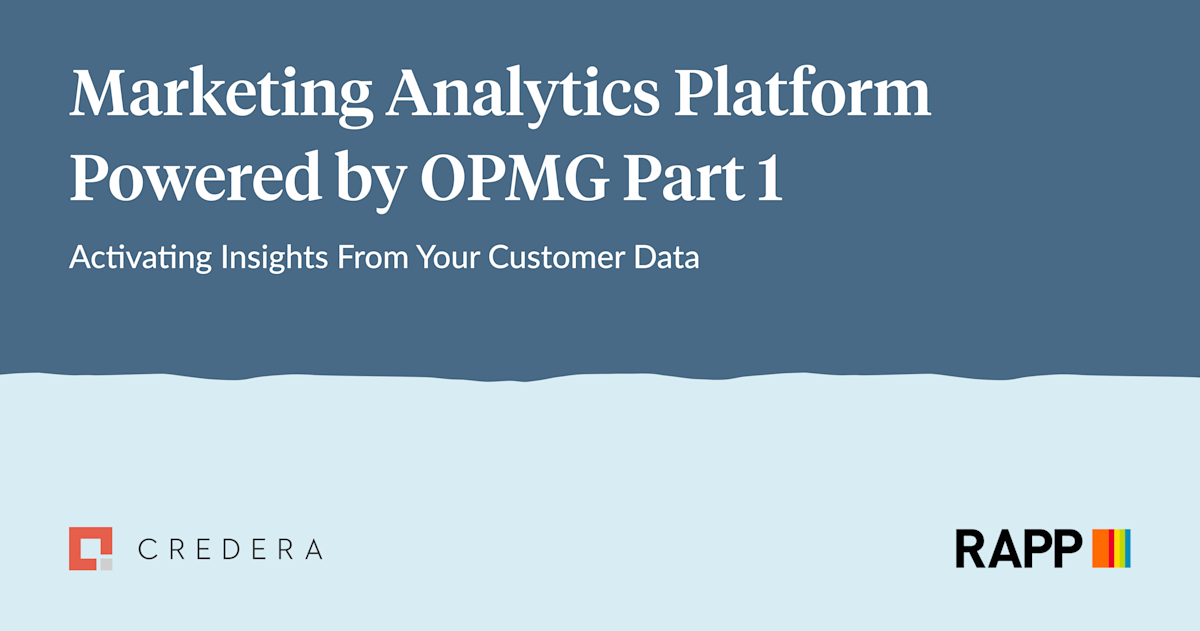Data
Feb 03, 2022
Marketing Analytics Platform Powered by OPMG Part 1: Activating Insights From Your Customer Data

Personalization has become a driving force in the ever-evolving ecommerce ecosystem, with 80% of consumers saying they are more likely to purchase when brands offer personalized experiences. Yet 48% of chief marketing officers believe their customer experience is not good enough, according to a Marketing Week study. While the omnichannel nature of modern customer journeys makes personalizing customer journeys harder than ever, it is critical when 32% of customers say they would stop doing business with a brand they love after only one bad experience, according to a 2018 study.
With today’s avalanche of omnichannel customer data, garnering actionable insights from fragmented customer experiences can paint only part of the picture, and possibly the wrong one. Assembling a comprehensive, accurate picture requires breaking down data silos and creating a unified single view of the customer.
A single customer view provides marketers with data they can trust, future-proofing their customer data based on robust data quality, real-time insights, and simplified integrations. This allows brands to harness customer data to better understand customer behaviors, identify their preferences, and provide personalized experiences at every step of their journey.
Creating a single customer view can feel like a daunting task, but can be simplified into a four-part process:

Step 1: Unify Your Customer Data Sources
Whether you intend it or not, your customers are likely interacting with your brand through more than one, if not all, of the following channels: website, mobile app, social media, advertisements, and physical stores. In fact, a Harvard Business Review study found that 73% of customers use an omnichannel experience.
To further complicate things, your customers may access these channels through a mobile device, desktop browser, or your point-of-sale system (POS). Oftentimes, data is housed separately in each of these areas. The first step in building a single view of the customer is unifying these disparate data sources at each step of the customer journey.
A customer data platform (CDP) is purpose built to serve as a centralized source of persistent data. But loading customer data into a CDP is only half of the battle, as the data must be standardized and transformed before being integrated. As an example, Tealium provides the ability to not only ingest data from any channel, but also to stich these data sources into a single view and enable true real-time segmentation and activation.
If the goal is to build a single customer profile for Mary Smith, you need to stitch together the interaction data from your mobile app (mary_smith35), your website (Mary.Smith), and your POS (MS10032044) to create a unique, singular profile. Only once you have data you can trust can you begin to garner insights from the full picture.
By breaking down data silos, you can enable profiles to be built in real time from omnichannel touchpoints. This enables deeper insights and personalized experiences at every step of the customer journey.

Step 2: Micro-Segment Your Customers
After stitching your customer data into a single customer view, you can begin to segment your customers based on specific behaviors and attributes. Unified customer data allows for more accurate, trustworthy, and valuable segmentation which sets the stage for customers to be engaged in ways that are most relevant to them.
This is more than just slotting your customers into preset demographics. By looking at the full customer experience, you can identify new micro-segments based on actual customer behavior and engagement. So instead of noting that Mary Smith is a woman with a recent purchase, you can understand she is a frequent mobile app user who primarily purchases on the website.
There are levels of maturity for segmentation. The segments described above were based on backward-looking models. Mature segmentation, on the other hand, leverages machine learning scoring models to break segments into micro-segments and derive insights from existing customer attributes to predict future customer behavior.
Using this approach, you can assign anonymous visitors to an existing customer micro-segment based on their observed behaviors. Once you have placed them in that segment you can provide them with personalized journeys and content. For instance, if someone with a similar profile to Mary Smith enters the website directly from the mobile app, you can predict that they are likely in a “buying” stage journey rather than an “awareness” stage journey based on Mary Smith’s conversion tendencies.
Step 3: Orchestrate Customer Experiences With Your MarTech Stack
The real power of a single view of a customer comes in the third step, which is the ability to alter customer engagement based on customer interests. Where traditional marketing applies a one-size-fits-all approach to customer communication, a unified customer profile enables an adaptable approach so each customer can be presented with the best content in the optimal channel at the opportune time.
This is accomplished with a next best action approach, which activates customer data in your CDP through pre-built integrations with the rest of your MarTech ecosystem. First, CDP products like Tealium provide the pre-built integrations that accelerate your time to value and allow for activation in real time. Then the next best action approach applies predictive and prescriptive machine learning algorithms to identify the optimal channel to deliver the optimal message at the optimal time. Think of it as putting your best foot forward with every customer interaction.
Take Mary Smith for instance: Based on her unified customer profile and segment, you know she prefers to browse on the mobile app and purchase on the website. So when a new product launches, your decision engine would trigger a next best action to send her a push notification for the product in the mobile app and present her with a discount code to encourage conversion when she enters the website.
Step 4: Measure & Optimize Your Personalization Performance
But orchestration is not the end of the process—the journey for providing unique, personalized customer experiences never truly ends. It is an iterative process focused on predicting future outcomes, measuring them, and then refining segmentation and next best action algorithms to align better to key performance indicators (KPIs).
Amazon Web Services (AWS) can be used to build the robust analytics required for this iterative optimization. Using a CDP such as Tealium to micro-segment your customer data, AWS native services allows you to ingest, model, transform, and analyze aggregated first- and third-party data. Amazon clean rooms then provide a collaborative environment to blend Amazon customer data with client first-party data that can be activated via Amazon Advertising.
Circling back to Mary Smith, we may measure her conversion rate after entering the website is higher after browsing shoes in the mobile app instead of clothing. We can then optimize her offer by adjusting the discount amount for clothing to incentivize the purchase.
By putting in place a data-driven feedback loop, you can enable the technologies and processes surrounding your single customer view strategy to not only better meet your customer’s current needs but also be nimble and adapt to their changing preferences.

Up Next in Our Marketing Analytics Platform Series
This is part one of a multi-part series exploring how a single customer view powered by Tealium and AWS can help you provide personalized customer experiences and increase the ROI of your marketing spend.
In part two, we continue the series by sharing how modern cloud data platforms, specifically marketing data platforms, enable marketers to accelerate these four steps and deliver differentiated precision marketing.
Interested in learning more about how Credera can help your company deliver personalized omnichannel experiences by enabling a single customer view? Reach out to one of our MarTech experts at marketing@credera.com to get the conversation started.
Marketing Analytics Platform Powered by OPMG
OPMG’s Marketing Analytics Platform (MAP) is a technology toolkit for marketing teams to unlock value from their customer data. The toolkit blends enterprise patterns, cloud technology, and off-the-shelf software to unify customer data, segment customers, orchestrate real-time experiences, and measure the customer journey.
This content was created in partnership between RAPP and Credera, sister agencies and part of Omnicom Precision Marketing Group (OPMG). Omnicom Precision Marketing Group aligns Omnicom's global digital, data and CRM capabilities to deliver precisely targeted and meaningful customer experiences at scale.
Contact Us
Let's talk!
We're ready to help turn your biggest challenges into your biggest advantages.
Searching for a new career?
View job openings






